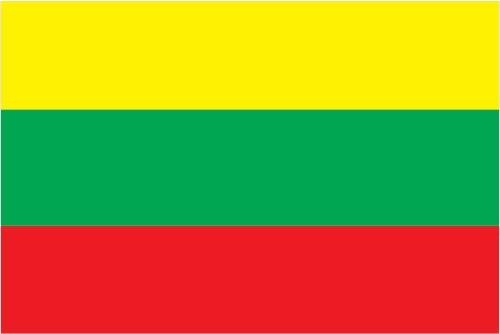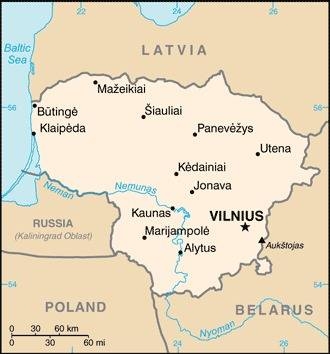89 Lithuania

Three equal horizontal bands of yellow (top), green, and red; yellow symbolizes golden fields, as well as the sun, light, and goodness. Green represents the forests of the countryside, in addition to nature, freedom, and hope. Red stands for courage and the blood spilled in defense of the homeland.
Flag courtesy of the CIA World Factbook

Map courtesy of the CIA World Factbook

Baltic amber was once a valuable trade resource. It was transported from the region of modern-day Lithuania to the Roman Empire and Egypt through the Amber Road.
Government
According to Britannica, Lithuania’s current constitution was approved by national referendum in 1992. The Republic of Lithuania, formerly the Lithuanian Soviet Socialist Republic, is administered by a president and a legislature, the Seimas, under a parliamentary system. The Seimas consists of 141 members, who are elected to four-year terms. The prime minister, formally appointed by the president, oversees the country’s day-to-day affairs and is generally the leader of the Seimas’s majority party. The president is popularly elected for a five-year term (with a maximum of two consecutive terms).
Lithuania is divided into apskritys (counties), which are then divided into rajonas (districts). The districts are further divided into savivalbyde (regional towns, urban settlements, and localities). The governor of each county is appointed by the national government. The districts are self-governing and elect local councils, which in turn elect the mayors.
Lithuania’s judicial system is headed by a Supreme Court and a Constitutional Court, whose judges are selected by the parliament. There are also district and local courts whose judges are appointed by the president for five-year terms.
Lithuanian Transport Safety Administration
The Ministry of Transport and Communications of the Republic of Lithuania shall be the institution implementing the rights and obligations of the body owner. In order to create a professional, innovative, business-oriented aviation surveillance system, the Civil Aviation Administration was restructured by transferring its functions to two other sector bodies – Lithuanian Transport Safety Administration and Transport Competence Agency (until 2019 Road and Transport Research Institute). The activities of Transport Competence Agency cover the following areas: licensing of specialists and supervision of their activities; the oversight, accreditation and licensing of aviation sector; planning of transport communications; transport monitoring and research. The purpose of the activity of Competence Agency is to contribute to the development of the public transport system in Lithuania and the supervision and development of the use of state resources allocated to it, ensuring the highest standards of quality, safety and security
Airspace
SkyVector – Google Maps – ADS-B Exchange
ICAO countries publish an Aeronautical Information Publication (AIP). This document is divided into three parts: General (GEN), En Route (ENR) and Aerodromes (AD). ENR 1.4 details the types of airspace classes they chose to adopt from classes A through G.
ON ANSP
ON ANSP – ON is a certified European air navigation service provider (ANSP), rendering air traffic management, communication, navigation and surveillance as well as aeronautical information services across the airspace of the Republic of Lithuania, also above the territorial waters and within the Baltic Sea airspace, which belongs to Vilnius flight information region (FIR). ON also ensures continuous operation of Aeronautical Rescue Coordination Centre, organization and coordination of search and rescue operations in case of an aircraft accident. Air navigation service providers are especially significant in the air transport value chain, since they ensure the management of air traffic flows and flight safety, furthermore, acting in cooperation with other stakeholders, they create added value for all the participants of air transport value chain.
Drone Regulations
Drone laws – National Regulation
Advanced Air Mobility (AAM) Regulations & Policies
Bilateral agreements facilitate the reciprocal airworthiness certification of civil aeronautical products imported/exported between two signatory countries. A Bilateral Airworthiness Agreement (BAA) or Bilateral Aviation Safety Agreement (BASA) with Implementation Procedures for Airworthiness (IPA) provides for airworthiness technical cooperation between the FAA and its counterpart civil aviation authorities.
Reciprocal acceptance of aviation safety-related approvals and services with the European Union Aviation Safety Agency (EASA) and Member States of the European Union are primarily governed by the U.S. – European Union Safety Agreement.
Advanced Air Mobility (AAM) News
2025 – Lithuanian Start-up Takes New Approach to Emergency Air Mobility
2025
Video courtesy of Advanced Air Mobility Institute from the July 2025 Global AAM Forum.
Short Essay Questions
Scenario-Based Question
You have been hired by a Drone Startup Company. Your boss has immediately assigned this job to you.
They need you to prepare a one-page memo detailing the legalities of using a drone to film in Lithuania.
They need you to mention any national laws and local ordinances.
They specifically want to know what airspace (insert pictures) you will be operating in and whether or not you need an airspace authorization.
Does it matter whether or not you are a citizen of the country?
Lastly, there is a bonus for you if, as you scroll through this chapter, you find any typos or broken links!
Short Essay Questions
- What are the drone categories?
- How is registration addressed?
- How is remote ID addressed?
- What are the model aircraft rules?
- What are the commercial drone rules?
- Are there waivers or exemptions to the rules? If so, for what?
- Would you share a link to an interactive airspace map?
- How is BVLOS addressed?
- How can you fly drones at night?
- How can you fly drones over people?
- Where do you find drone NOTAMs?
- What are the rules for drone maintenance?
- What are the rules for an SMS program?
- What are some unique rules not mentioned above?
- What are the C-UAS rules?
- What are the AAM rules?

